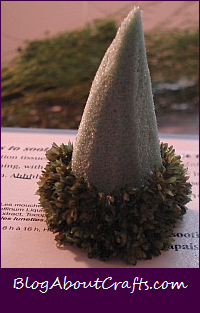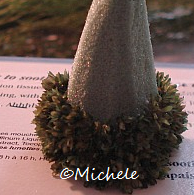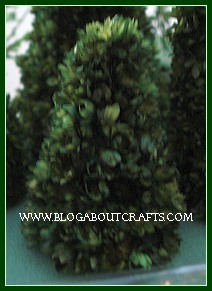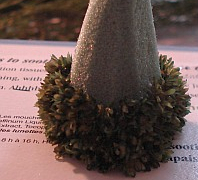 Google Images, Pinterest and Duitang have made the issue of watermarking photos more important than ever.
Google Images, Pinterest and Duitang have made the issue of watermarking photos more important than ever.
While a determined thief won’t let a watermark stop them, they are a way to brand your images and somewhat protect your copyrights.
One of my biggest Pinterest frustrations is how bloggers are writing about someone else’s work and then pinning the photos with a link, not to the original creator, but their review of that person’s work. I really get the desire to promote your blog. But, if you really want to promote an artist, you should link directly to the true source.
Since, so many refuse to do that, we all have to develop strategies to ensure photos can be traced back to the true source through watermarks.
I’ve recently been experimenting with ways to ensure it is the original artist and not Blog About Crafts that gets linked to the talented folks I showcase on my Featured Artist posts. I will be implementing digital watermarking for all future posts.
Digital Watermarks
There are a number of techniques for adding digital watermarks to photos. You will have to determine how much image distortion you can live with. But, keep in mind, a watermark also should be part of your branding strategy.
Copyright & Digital Signatures
 You could go old school with a signature. Unfortunately, that doesn’t really brand your work.
You could go old school with a signature. Unfortunately, that doesn’t really brand your work.
Anonymous Etsians, Etsians who list themselves as “male” or “female” and don’t include their name, would only confuse things by using their signature. And, don’t most artists name their shop name after something other than their name anyway?
As unique as I always thought Michele (with one ‘l’) Tway is, there is actually another women with the same name on Facebook. She doesn’t mention being a writer on her page but a potential client assumed we were the same person. Uh, oh. (note to self, work on fixing that issue)
However, if I use my site name (BlogAboutCrafts.com or YourMessageConsultant.com) as my brand, it will always lead back to me.
Keep in mind, this conversation is about digital watermarking. I’m in no way suggesting that an artist should physically sign their work with anything other than their name or nom de plume.
Name Overlay
 Long-term readers might recognize these little trees from my Christmas Village Tree Tutorial.
Long-term readers might recognize these little trees from my Christmas Village Tree Tutorial.
As you can see, this picture contains a digital watermark with the URL of this site.
This type of watermarking is the hardest to remove. If you put the watermark near the edge of the photo where it intrudes on the image the least, thieves simply crop it off or blur it off. Placed in the middle of the image, the watermark becomes harder to remove without damaging the image.
I’ve spoken to several folks selling their crafts online and they hate using watermarks. They worry it ‘damages the appearance of their items’. Some even mentioned that customers complained watermarks make it harder to see the item being offered for sale. The felt watermarking actually hurt sales.
For the most part, this is how I watermarked my photos. I’m not selling my work, so the salesmanship issue doesn’t really impact me. I did however, often spend time on finding the least intrusive spot, the most readable text and a size that allowed for all of the text to fit.
From a branding perspective, digital watermarks should be consistently applied. This style of watermark doesn’t really lend itself to that. Depending on the colors and complexity of the image, text size, color and even the font may have to change with each photo.
Background as a Watermark
 You can use the photo itself as your watermark.
You can use the photo itself as your watermark.
The written text in the background of this image, could easily include my site name, URL or other identifying information.
It doesn’t. But, with the mixed media art trend of written text in backgrounds, this might be a more subtle way of digitally watermarking your images.
Handwriting would also be an effective choice.
This type of watermarking would help if you ever pursued the copyright infringement in court, but may offer only limited branding.
Digital Watermarking Photos with Frames
 In my experimenting with watermarking for my Featured Artist Program posts, I think frames offer the cleanest way to proclaim ownership without damaging the image itself.
In my experimenting with watermarking for my Featured Artist Program posts, I think frames offer the cleanest way to proclaim ownership without damaging the image itself.
Granted it’s the easiest of the digital watermarks to remove but we all know determined thieves don’t really care about damaging the image.
Digital watermarking with frames offers a great way to consistently mark your photos. You can standardize the font, the size of the letters and the color(s) of the frame you use. It also puts a ‘finished edge’ on your images.
Among all of the digital watermark techniques, this one says “Don’t steal this image sign” the least. It also leaves the image itself intact and helps to build brand awareness.
Google Images and Pinterest users post the full image. Any framed watermark would be included. Anyone looking at the search results or pin would know exactly where the original photo came from.
Disabling Right Click
I thought I would take a moment to discuss the strategy of disabling right clicking to prevent folks from copying your images.
It is a waste of time!
Two keystrokes and your image is captured. Alt/Print Screen and an image editor is all it takes.
Now that the thief has their image editor already open, they will probably crop off or blur out your watermark too.
At least if you allow them to right click and save the image, your watermark may be left in place.
Blocking Pins & Watermarking
Blocking Pinterest users from pinning your images is another useless strategy. In my mind, it can actually hurt you rather than help you.
Alt/print screen and Google Image Search will overcome any plugin, program or script to block pinners. If a Pinterest member directly uploads your image or pins the image results, they don’t link to your site.
And, many of the folks I’ve seen promoting using these plugins don’t watermark their images. So, once the image is pinned via upload or Google search, only a bit of luck by a determined Pinterest member, who takes the time to search for the source, will lead them back to you.
You lose the link and the branding.
It’s a short-sighted strategy that offers only limited copyright protection for your images. It also puts you firmly in the anti-Pinterest crowd which could actually hurt your brand in the long run.
Watermarking Images
In the end, watermarking images should be a business decision. I’ve come to believe that they have become a necessary evil. Not watermarking your images just makes it easier for people to borrow or outright steal your work.
The trick becomes finding a watermarking technique that provides some level of image protection without ruining the image.
What Digital Watermarking Strategy Do You Use?
Do you use digital watermarks? How do style them? What led you to decide to include them or leave them off? Have you seen where watermarking has hurt your sales?